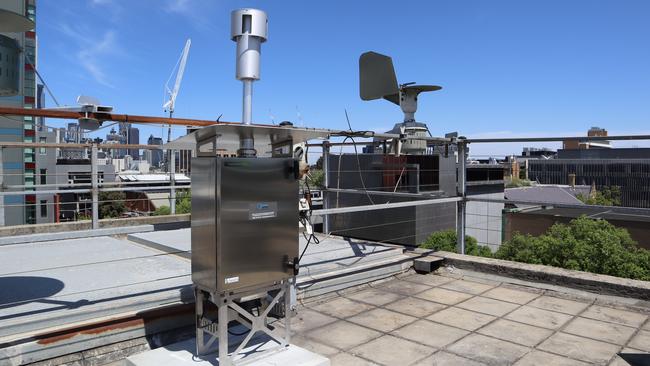Australian-first automated pollen counter at Melbourne University offers help for hay fever sufferers
An Australian-first automated pollen counter installed on a roof at Melbourne University will help millions of hay fever sufferers.

Victoria
Don't miss out on the headlines from Victoria. Followed categories will be added to My News.
An Australian-first automated pollen counter installed on a roof at Melbourne University is expected to revolutionise hay fever management.
Researchers will be able to record continual pollen counts, 24 hours a day, every day.
The information gathered will help with pollen forecasts and the health implications for millions of hay fever and asthma sufferers, including those affected by the potentially deadly thunderstorm asthma.
Associate Professor Ed Newbigin and Dr Edwin Lampugnani, who co-ordinate the Melbourne Pollen Service, said the automated pollen counter was “a game changer” in counting, tracking and understanding pollen.

“The trap takes away the laboriousness of sitting under a microscope doing the daily count and lets us focus on interpreting the data,” Associate Professor Newbigin said.
About 23 per cent of Victorians – or about one in four people – suffer from hay fever, according to an Australian Institute of Health and Welfare report in 2018.
Grass pollen is the main cause of hay fever and asthma in Victoria. Melbourne’s grass pollen season starts in spring, usually peaking in mid-to-late November and then eases by the end of the year.
We know pollen and now you can too. Download the App now: https://t.co/uQQUlJXWTdpic.twitter.com/VZPrmMCeqO
— Melbourne Pollen Count and Forecast (@MelbournePollen) November 29, 2021
The city’s most recent pollen season was slightly above average and less severe than the “monster’’ season experienced across southern Victoria in 2020, Associate Professor Newbigin said
The annual pollen increase also coincided with the peak in hospital admissions for asthma and thunderstorm asthma, he said.

“Thunderstorm asthma is an acute event of allergy in the community that comes on rapidly. The pollen counter will provide better time resolution of data so we can know what was in the air at the time, helping us to better understand these severe health incidents,” Associate Professor Newbigin said.
The information will be added to the Melbourne Pollen Count app – subscribers to the service have helped to fund the new counter.
#Melbourne grass #pollen forecast for today (Wednesday, Jan 12) is Moderate. Get the App for more pollen forecasts: https://t.co/9tGM9P1yxQ
— Melbourne Pollen Count and Forecast (@MelbournePollen) January 11, 2022
Note: Other locations within Victoria have a High forecast today. pic.twitter.com/KsArfFTQ0m
The new measuring unit has been installed on top of the uni’s McCoy building at the corner of Swanston and Elgin streets.
The state’s pollen count is recorded by counters which are operated by Melbourne and Deakin universities at eight locations – Hamilton, Creswick, Bendigo, Dookie, Burwood, Parkville, Waurn Ponds and Churchill.
Dr Lampugnani said he hoped the Parkville counter would be the first step in the creation of an Australia-wide automated network.
“With enough support, we can develop Australia’s first automated bio-aerosol monitoring network, capturing not just pollen, but other airborne biological materials, such as mould spores,” he said.



